Last Updated on January 28, 2021 by Admin
CCNA2 v6.0 Chapter 2 Exam Answers 2019
From year to year, Cisco has updated many versions with difference questions. The latest version is version 6.0 in 2018. What is your version? It depends on your instructor creating your class. We recommend you to go thought all version if you are not clear. While you take online test with netacad.com, You may get random questions from all version. Each version have 1 to 10 different questions or more. After you review all questions, You should practice with our online test system by go to "Online Test" link below.
-
What are two advantages of static routing over dynamic routing? (Choose two.)
- Static routing is more secure because it does not advertise over the network.
- Static routing scales well with expanding networks.
- Static routing requires very little knowledge of the network for correct implementation.
- Static routing uses fewer router resources than dynamic routing.
- Static routing is relatively easy to configure for large networks.
Explanation: Static routing requires a thorough understanding of the entire network for proper implementation. It can be prone to errors and does not scale well for large networks. Static routing uses fewer router resources, because no computing is required for updating routes. Static routing can also be more secure because it does not advertise over the network.
-
Refer to the exhibit. What routing solution will allow both PC A and PC B to access the Internet with the minimum amount of router CPU and network bandwidth utilization?
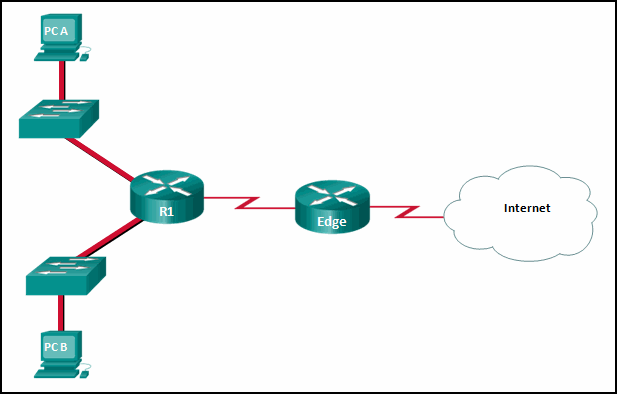
CCNA2 v6.0 Chapter 2 Exam 007
- Configure a static route from R1 to Edge and a dynamic route from Edge to R1.
- Configure a static default route from R1 to Edge, a default route from Edge to the Internet, and a static route from Edge to R1.
- Configure a dynamic route from R1 to Edge and a static route from Edge to R1.
- Configure a dynamic routing protocol between R1 and Edge and advertise all routes.
Explanation: Two routes have to be created: a default route in R1 to reach Edge and a static route in Edge to reach R1 for the return traffic. This is a best solution once PC A and PC B belong to stub networks. Moreover, static routing consumes less bandwidth than dynamic routing.
-
What is the correct syntax of a floating static route?
- ip route 209.165.200.228 255.255.255.248 serial 0/0/0
- ip route 209.165.200.228 255.255.255.248 10.0.0.1 120
- ip route 0.0.0.0 0.0.0.0 serial 0/0/0
- ip route 172.16.0.0 255.248.0.0 10.0.0.1
Explanation: Floating static routes are used as backup routes, often to routes learned from dynamic routing protocols. To be a floating static route, the configured route must have a higher administrative distance than the primary route. For example, if the primary route is learned through OSPF, then a floating static route that serves as a backup to the OSPF route must have an administrative distance greater than 110. The administrative distance on a floating static route is put at the end of the static route: ip route 209.165.200.228 255.255.255.248 10.0.0.1 120.
-
What is a characteristic of a static route that matches all packets?
- It backs up a route already discovered by a dynamic routing protocol.
- It uses a single network address to send multiple static routes to one destination address.
- It identifies the gateway IP address to which the router sends all IP packets for which it does not have a learned or static route.
- It is configured with a higher administrative distance than the original dynamic routing protocol has.
Explanation: A default static route is a route that matches all packets. It identifies the gateway IP address to which the router sends all IP packets for which it does not have a learned or static route. A default static route is simply a static route with 0.0.0.0/0 as the destination IPv4 address. Configuring a default static route creates a gateway of last resort.
-
What type of route allows a router to forward packets even though its routing table contains no specific route to the destination network?
- dynamic route
- default route
- destination route
- generic route
-
Why would a floating static route be configured with an administrative distance that is higher than the administrative distance of a dynamic routing protocol that is running on the same router?
- to be used as a backup route
- to load-balance the traffic
- to act as a gateway of last resort
- to be the priority route in the routing table
Explanation: By default, dynamic routing protocols have a higher administrative distance than static routes. Configuring a static route with a higher administrative distance than that of the dynamic routing protocol will result in the dynamic route being used instead of the static route. However, should the dynamically learned route fail, then the static route will be used as a backup.
-
A company has several networks with the following IP address requirements:
IP phones – 50
PCs – 70
IP cameras – 10
wireless access points – 10
network printers – 10
network scanners – 2Which block of addresses would be the minimum to accommodate all of these devices if each type of device was on its own network?
- 172.16.0.0/25
- 172.16.0.0/24
- 172.16.0.0/23
- 172.16.0.0/22
Explanation: The network for the PCs would require a subnet mask of /25 in order to accommodate 70 devices. That network could use IP addresses 0 through 127. Phones require a subnet mask of /26 for 50 devices (addresses 128-191). Three /28 networks are needed in order to accommodate cameras, APs, and printers. The network scanner network can use a /30. A block of addresses with a mask of /24 will accommodate this site as the minimum amount needed.
-
What happens to a static route entry in a routing table when the outgoing interface associated with that route goes into the down state?
- The static route is removed from the routing table.
- The router polls neighbors for a replacement route.
- The static route remains in the table because it was defined as static.
- The router automatically redirects the static route to use another interface.
Explanation: When the interface associated with a static route goes down, the router will remove the route because it is no longer valid.
-
The network administrator configures the router with the ip route 172.16.1.0 255.255.255.0 172.16.2.2 command. How will this route appear in the routing table?
- C 172.16.1.0 is directly connected, Serial0/0
- S 172.16.1.0 is directly connected, Serial0/0
- C 172.16.1.0 [1/0] via 172.16.2.2
- S 172.16.1.0 [1/0] via 172.16.2.2
-
Refer to the exhibit. What two commands will change the next-hop address for the 10.0.0.0/8 network from 172.16.40.2 to 192.168.1.2? (Choose two.)
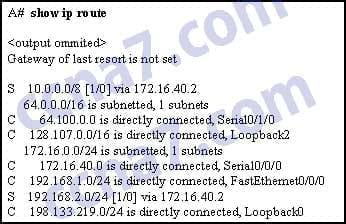
CCNA2 v6.0 Chapter 2 Exam 009
- A(config)# no network 10.0.0.0 255.0.0.0 172.16.40.2
- A(config)# no ip address 10.0.0.1 255.0.0.0 172.16.40.2
- A(config)# no ip route 10.0.0.0 255.0.0.0 172.16.40.2
- A(config)# ip route 10.0.0.0 255.0.0.0 s0/0/0
- A(config)# ip route 10.0.0.0 255.0.0.0 192.168.1.2
Explanation: The two required commands are A(config)# no ip route 10.0.0.0 255.0.0.0 172.16.40.2 and A(config)# ip route 10.0.0.0 255.0.0.0 192.168.1.2.
-
Which type of static route that is configured on a router uses only the exit interface?
- recursive static route
- directly connected static route
- fully specified static route
- default static route
Explanation: When only the exit interface is used, the route is a directly connected static route. When the next-hop IP address is used, the route is a recursive static route. When both are used, it is a fully specified static route.
-
Refer to the graphic. Which command would be used on router A to configure a static route to direct traffic from LAN A that is destined for LAN C?
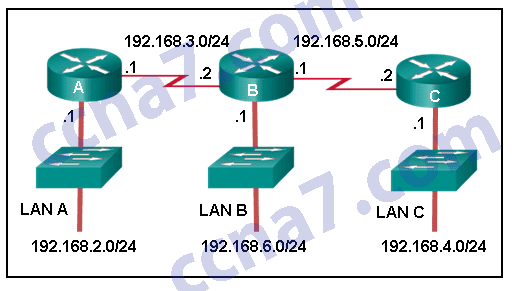
CCNA2 v6.0 Chapter 2 Exam 005
- A(config)# ip route 192.168.4.0 255.255.255.0 192.168.5.2
- A(config)# ip route 192.168.4.0 255.255.255.0 192.168.3.2
- A(config)# ip route 192.168.5.0 255.255.255.0 192.168.3.2
- A(config)# ip route 192.168.3.0 255.255.255.0 192.168.3.1
- A(config)# ip route 192.168.3.2 255.255.255.0 192.168.4.0
Explanation: The destination network on LAN C is 192.168.4.0 and the next-hop address from the perspective of router A is 192.168.3.2.
-
Refer to the exhibit. The network administrator needs to configure a default route on the Border router. Which command would the administrator use to configure a default route that will require the least amount of router processing when forwarding packets?
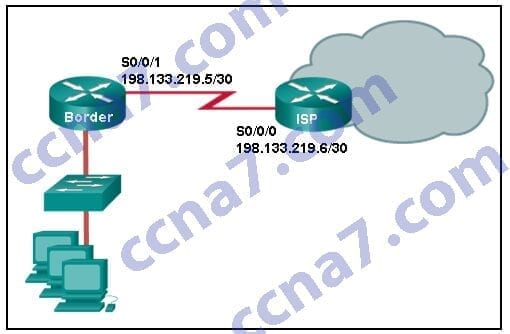
CCNA2 v6.0 Chapter 2 Exam 006
- Border(config)# ip route 0.0.0.0 0.0.0.0 198.133.219.5
- Border(config)# ip route 0.0.0.0 0.0.0.0 198.133.219.6
- Border(config)# ip route 0.0.0.0 0.0.0.0 s0/0/1
- Border(config)# ip route 0.0.0.0 0.0.0.0 s0/0/0
Explanation: The default route configured with the next-hop option requires a recursive lookup.
-
What two pieces of information are needed in a fully specified static route to eliminate recursive lookups? (Choose two.)
- the interface ID exit interface
- the interface ID of the next-hop neighbor
- the IP address of the next-hop neighbor
- the administrative distance for the destination network
- the IP address of the exit interface
Explanation: A fully specified static route can be used to avoid recursive routing table lookups by the router. A fully specified static route contains both the IP address of the next-hop router and the ID of the exit interface.
-
Refer to the exhibit. What command would be used to configure a static route on R1 so that traffic from both LANs can reach the 2001:db8:1:4::/64 remote network?

CCNA2 v6.0 Chapter 2 Exam 001
- ipv6 route ::/0 serial0/0/0
- ipv6 route 2001:db8:1:4::/64 2001:db8:1:3::1
- ipv6 route 2001:db8:1:4::/64 2001:db8:1:3::2
- ipv6 route 2001:db8:1::/65 2001:db8:1:3::1
Explanation: To configure an IPv6 static route, use the ipv6 route command followed by the destination network. Then add either the IP address of the adjacent router or the interface R1 will use to transmit a packet to the 2001:db8:1:4::/64 network.
-
Refer to the exhibit. Which default static route command would allow R1 to potentially reach all unknown networks on the Internet?
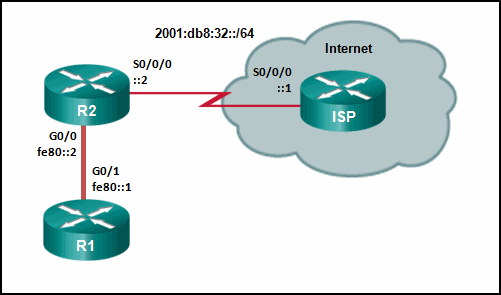
CCNA2 v6.0 Chapter 2 Exam 002
- R1(config)# ipv6 route 2001:db8:32::/64 G0/0
- R1(config)# ipv6 route ::/0 G0/0 fe80::2
- R1(config)# ipv6 route ::/0 G0/1 fe80::2
- R1(config)# ipv6 route 2001:db8:32::/64 G0/1 fe80::2
Explanation: To route packets to unknown IPv6 networks a router will need an IPv6 default route. The static route ipv6 route ::/0 G0/1 fe80::2 will match all networks and send packets out the specified exit interface G0/1 toward R2.
-
Consider the following command:
ip route 192.168.10.0 255.255.255.0 10.10.10.2 5
Which route would have to go down in order for this static route to appear in the routing table?
- a default route
- a static route to the 192.168.10.0/24 network
- an OSPF-learned route to the 192.168.10.0/24 network
- an EIGRP-learned route to the 192.168.10.0/24 network
Explanation: The administrative distance of 5 added to the end of the static route creates a floating static situation for a static route that goes down. Static routes have a default administrative distance of 1. This route that has an administrative distance of 5 will not be placed into the routing table unless the previously entered static route to the 192.168.10.0/24 goes down or was never entered. The administrative distance of 5 added to the end of the static route configuration creates a floating static route that will be placed in the routing table when the primary route to the same destination network goes down. By default, a static route to the 192.168.10.0/24 network has an administrative distance of 1. Therefore, the floating route with an administrative distance of 5 will not be placed into the routing table unless the previously entered static route to the 192.168.10.0/24 goes down or was never entered. Because the floating route has an administrative distance of 5, the route is preferred to an OSPF-learned route (with the administrative distance of 110) or an EIGRP-learned route (with the administrative distance of 110) to the same destination network.
-
Refer to the exhibit. The routing table for R2 is as follows:
Gateway of last resort is not set
10.0.0.0/30 is subnetted, 2 subnets
C 10.0.0.0 is directly connected, Serial0/0/0
C 10.0.0.4 is directly connected, Serial0/0/1
192.168.10.0/26 is subnetted, 3 subnets
S 192.168.10.0 is directly connected, Serial0/0/0
C 192.168.10.64 is directly connected, FastEthernet0/0
S 192.168.10.128 [1/0] via 10.0.0.6What will router R2 do with a packet destined for 192.168.10.129?
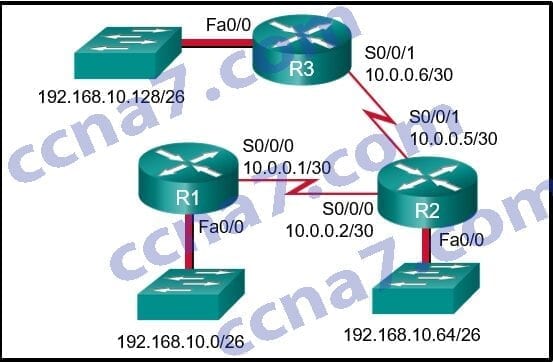
CCNA2 v6.0 Chapter 2 Exam 008
- drop the packet
- send the packet out interface Serial0/0/0
- send the packet out interface Serial0/0/1
- send the packet out interface FastEthernet0/0
Explanation: When a static route is configured with the next hop address (as in the case of the 192.168.10.128 network), the output of the show ip route command lists the route as “via” a particular IP address. The router has to look up that IP address to determine which interface to send the packet out. Because the IP address of 10.0.0.6 is part of network 10.0.0.4, the router sends the packet out interface Serial0/0/1.
-
A network administrator has entered a static route to an Ethernet LAN that is connected to an adjacent router. However, the route is not shown in the routing table. Which command would the administrator use to verify that the exit interface is up?
- show ip interface brief
- show ip protocols
- show ip route
- tracert
Explanation: The network administrator should use the show ip interface brief command to verify that the exit interface or the interface connected to the next hop address is up and up. The show ip route command has already been issued by the administrator. The show ip protocols command is used when a routing protocol is enabled. The tracert command is used from a Windows PC.
-
Consider the following command:
ip route 192.168.10.0 255.255.255.0 10.10.10.2 5
How would an administrator test this configuration?
- Delete the default gateway route on the router.
- Ping any valid address on the 192.168.10.0/24 network.
- Manually shut down the router interface used as a primary route.
- Ping from the 192.168.10.0 network to the 10.10.10.2 addres
Explanation: A floating static is a backup route that only appears in the routing table when the interface used with the primary route is down. To test a floating static route, the route must be in the routing table. Therefore, shutting down the interface used as a primary route would allow the floating static route to appear in the routing table.
-
Refer to the exhibit. The small company shown uses static routing. Users on the R2 LAN have reported a problem with connectivity. What is the issue?
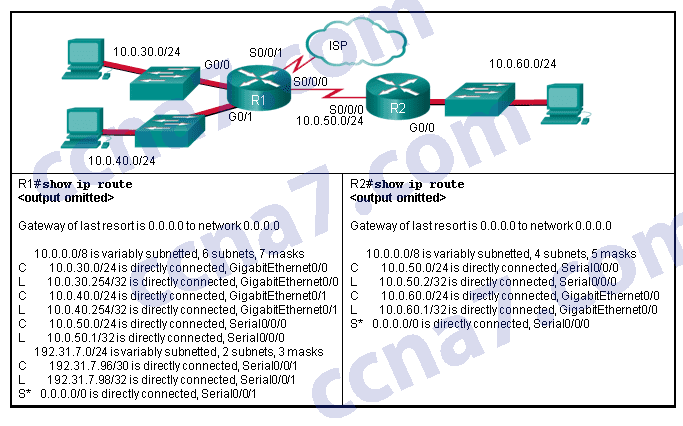
CCNA2 v6.0 Chapter 2 Exam 003
- R2 needs a static route to the R1 LANs.
- R1 and R2 must use a dynamic routing protocol.
- R1 needs a default route to R2.
- R1 needs a static route to the R2 LAN.
- R2 needs a static route to the Internet.
Explanation: R1 has a default route to the Internet. R2 has a default route to R1. R1 is missing a static route for the 10.0.60.0 network. Any traffic that reached R1 and is destined for 10.0.60.0/24 will be routed to the ISP.
-
Which three IOS troubleshooting commands can help to isolate problems with a static route? (Choose three.)
- show version
- ping
- tracert
- show ip route
- show ip interface brief
- show arp
Explanation: The ping, show ip route, and show ip interface brief commands provide information to help troubleshoot static routes. Show version does not provide any routing information. The tracert command is used at the Windows command prompt and is not an IOS command. The show arp command displays learned IP address to MAC address mappings contained in the Address Resolution Protocol (ARP) table.
-
An administrator issues the ipv6 route 2001:db8:acad:1::/32 gigabitethernet0/0 2001:db8:acad:6::1 100 command on a router. What administrative distance is assigned to this route?
- 0
- 1
- 32
- 100
Explanation: The command ipv6 route 2001:db8:acad:1::/32 gigabitethernet0/0 2001:db8:acad:6::1 100 will configure a floating static route on a router. The 100 at the end of the command specifies the administrative distance of 100 to be applied to the route.
-
Refer to the exhibit. The network engineer for the company that is shown wants to use the primary ISP connection for all external connectivity. The backup ISP connection is used only if the primary ISP connection fails. Which set of commands would accomplish this goal?
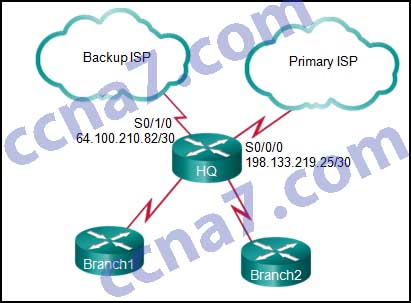
CCNA2 v6.0 Chapter 2 Exam 004
- ip route 198.133.219.24 255.255.255.252
ip route 64.100.210.80 255.255.255.252 - ip route 198.133.219.24 255.255.255.252
ip route 64.100.210.80 255.255.255.252 10 - ip route 0.0.0.0 0.0.0.0 s0/0/0
ip route 0.0.0.0 0.0.0.0 s0/1/0 - ip route 0.0.0.0 0.0.0.0 s0/0/0
ip route 0.0.0.0 0.0.0.0 s0/1/0 10Explanation: A static route that has no administrative distance added as part of the command has a default administrative distance of 1. The backup link should have a number higher than 1. The correct answer has an administrative distance of 10. The other quad zero route would load balance packets across both links and both links would appear in the routing table. The remaining answers are simply static routes (either a default route or a floating static default route).
- ip route 198.133.219.24 255.255.255.252
-
Open the PT Activity. Perform the tasks in the activity instructions and then answer the question.
Why are the pings from PC0 to Server0 not successful?
- The static route to network 192.168.1.0 is misconfigured on Router1.
- The static route to network 192.168.1.0 is misconfigured on Router2.
- The static route to network 192.168.2.0 is misconfigured on Router1.
- The static route to network 192.168.2.0 is misconfigured on Router2.
Explanation: Static routes should specify either a local interface or a next-hop IP address.
-
Open the PT Activity. Perform the tasks in the activity instructions and then answer the question.
What IPv6 static route can be configured on router R1 to make a fully converged network?
- ipv6 route 2001:db8:10:12::/64 S0/0/1
- ipv6 route 2001:db8:10:12::/64 S0/0/0
- ipv6 route 2001:db8:10:12::/64 2001:db8:10:12::1
- ipv6 route 2001:db8:10:12::/64 2001:db8:32:77::1
Explanation: To reach the remote network, R1 will need a static route with a destination IPv6 address of 2001:db8:10:12::/64 and an exit interface of S0/0/1. The correct static route configuration will be as follows: ipv6 route 2001:db8:10:12::/64 S0/0/1.
From year to year, Cisco has updated many versions with difference questions. The latest version is version 6.0 in 2018. What is your version? It depends on your instructor creating your class. We recommend you to go thought all version if you are not clear. While you take online test with netacad.com, You may get random questions from all version. Each version have 1 to 10 different questions or more. After you review all questions, You should practice with our online test system by go to "Online Test" link below.